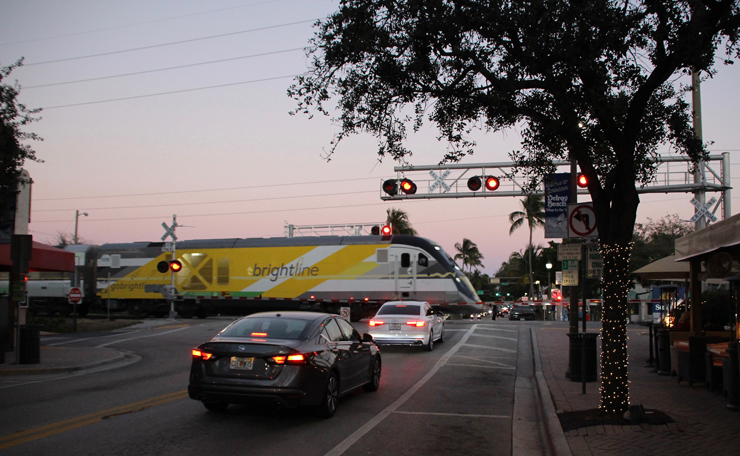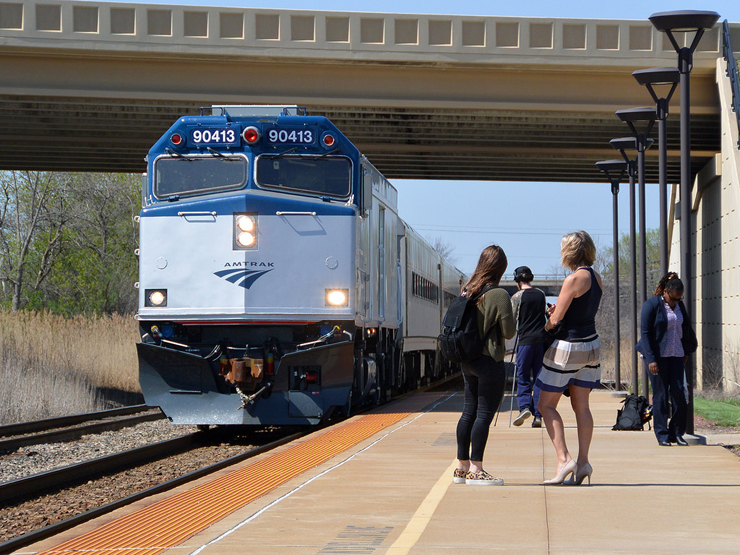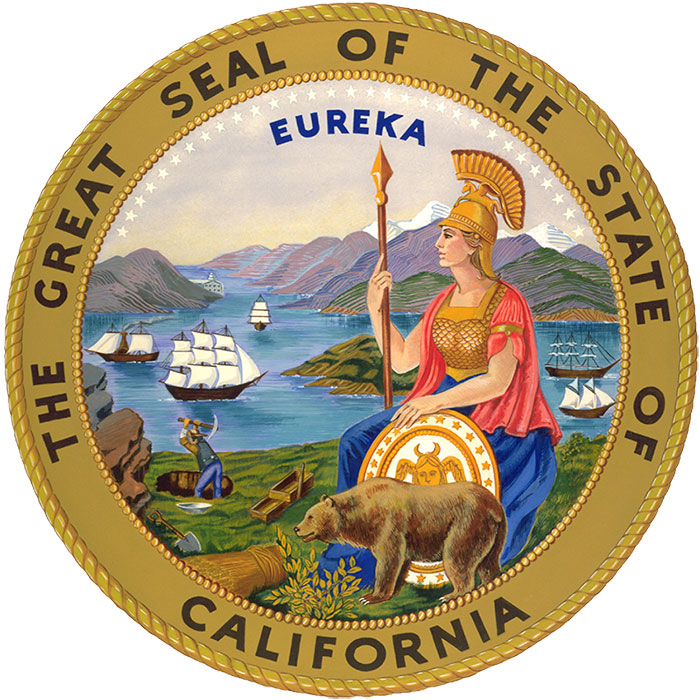WASHINGTON — The Federal Railroad Administration has announced more than $56 million in grants, covering 18 projects in 16 states, to improve rail safety, efficiency, and reliability through the Consolidated Rail Infrastructure and Safety Improvements program.
At least 25 percent of the funding was reserved for rural projects.
The largest award, up to $10 million, is for the Millbrook Road grade separation sealed corridor project on the CSX S Line north of Raliegh, N.C. It combines three projects, with two primarily funded by the state and the other advanced by the federal grant.
Other projects to receive grants, by state and with the funding amount in parentheses, are:
— Arkansas: Improved signage and pavement markings at 298 highway grade crossings on U.S. and state routes (up to $685,000).
— Florida: Installs supplemental safety features at 48 grade crossings on the Brightline/Virgin Trains USA route between West Palm Beach and Miami, decreasing the frequency of grade-crossing violations by keeping motorists and pedestrians from trespassing as trains approach (up to $2.73 million)
— Georgia: Upgrading right of way on the state-owned Heart of Georgia Railroad to FRA Class 2 standards, allowing operating speeds up to 25 mph. The project will replace 3,200 ties, place 2,000 tons of ballast on 5 miles of track, and enable repairs on 45 bridges, addressing 8.6 miles of slow orders and potentially reducing travel time by 90 minutes on what is currently a 12-hour trip across the 138-mile route (up to $2.03 million).
— Illinois: Reconfiguring the Lenox Interlocking in Mitchell, approximately 16 miles northeast of St. Louis, to increase speeds and operating flexibility. Four lines intersect at the site, with six railroads operating approximately 46 trains per day; the project will reduce Amtrak trip times by 3 minutes and reduce freight delays and crossing-gate activation time by more than 2 hours per day (up to $5.08 million)
— Iowa: Replace Iowa Interstate’s 118-year-old Booneville Bridge over the Raccoon River, 15 miles west of Des Moines. Under current conditions, the bridge will need to be placed out of service in the near future (up to $3.47 million).
— Mississippi: Install a four-quadrant gate system at a grade crossing in Gulfport that sees approximately 23 CSX Transportation trains per day and traffic volume of almost 50,000 vehicles per day (up to $58,800).
— Missouri: Grade crossing consolidation and other improvements on a 19-mile segment of track in southwest Missouri. Five crossings will be closed and nine others will receive safety improvements (up to $2.59 million).
— Missouri: Replace the Broadway Truss of the Terminal Railway Association of St. Louis’ MacArthur Bridge across the Mississippi River, a more than 100-year-old structure and the nation’s second longest railroad bridge. In addition to avoiding a projected closure of the bridge because of fatigue, the work will increase horizontal clearance, ending the diversion of oversized loads on a 317-mile reroute (up to $7.17 million).
— New York: Replacement of timber bridge decks with ballast decks on three bridges on the Hudson Line in Dutchess and Columbia counties. The work will eliminate current speed restrictions and allow for future 110-mph operation. The route sees 26 Amtrak trains per day as well as freight service (up to $6.36 million).
— Oregon: Completion of a multiphase project to increase speeds and alleviate congestion on two BNSF Railway junctions in Portland. Replacement and upgrade of two switches, along with a track realignment, will allow trains to maintain a constant 30 mph through the North Portland and Peninsula junctions; the site currently experiences up to 7 hours of delays per day because of congestion (up to $1.3 million).
— Rhode Island: Expand operations at the Quonset Business Park in North Kingston with the construction of 5,700 feet of sidings, capable of storing up to 58 railcars (up to $3 million).
— South Dakota: Upgrade of 2.5 miles of 100-year-old, 100-pound rail with 115-pound welded rail on the Rapid City, Pierre & Eastern Railroad near Wall, S.D. This will eliminate current conditions that require trains to slow from 25 mph to 10 mph as they enter a steeper grade (up to $978,000).
— Texas: Installs more than 13,000 new ties and 13,000 tones of ballast on the Class III Panhandle Northern Railroad in Borger, Texas, decreasing derailment risk on a line that transports more than 20,000 carloads of hazardous materials annually (up to $2.16 million).
— Vermont: Stablizes slopes along an 80-mile section of the New England Central Railroad used by Amtrak’s Vermonter, eliminating slow orders that have resulted in 216 hours of annual passenger delays and 520 hours of freight delays as well as decreasing safety risks (up to $2.08 million).
— Washington: Installs landslide fencing, catchment walls, and drainage improvements at two locations in Mukilteo, north of Seattle. The project areas have experienced 13 landslides in the last nine years (up to $2.04 million).
— Washington: Funds planning for potential infrastructure improvements on the corridor between Vancouver, British Columbia, and Portland, Ore. (up to $500,000).
— Wisconsin: Construct a second platform, elevator towers, and an overhead pedestrian bridge at the Milwaukee Airport Amtrak station, allowing passenger trains to use both tracks and ease congestion resulting from the current single-track configuration for passenger service (up to $5.05 million).















The Broadway Street Truss in St Louis is one of the last kinks in the TRRA MacArthur Bridge plan. They already took out the 1926 era roadway above the river bridge tracks (that gained them 50-60 years). The 1926 car truss over Broadway is still there next to the rail truss, but I am pretty sure it will get demolished when the rail truss is replaced.as it has been out of use since 1966.
John – Canadian Pacific has the whole railroad overnight, from Techny (Illinois) to central Wisconsin. Not a single passenger train, neither the Hiawatha nor the Empire Builder, is scheduled at night. But, John, that’s not the point. It’s Canadian Pacific’s railroad, not Amtrak’s. If a freight is scheduled out of Calgary or Bensenville at a time so as to pass Techny WB or pass Milwaukee EB when there is the most Amtrak traffic (the afternoon), that’s the railroad’s business. I’d love to live in a world that could have hourly Hiawathas along with four times daily trains to Minneapolis, with CP Rail freights keeping out of their way. I don’t live in that world. Amtrak doesn’t own a single inch of rail line in Wisconsin.
Like many other railroads, Canadian Pacific removed the second track on its main line, so it’s a single iron railroad west of Pewaukee (Waukesha County), Wisconsin. I have seen plenty of freights slowing to a crawl WB through Duplainville approaching the end of double iron in Pewaukee. If CP Rail were still a double track railroad, these freights would pass at speed. Driving on STH 16 through Nashotah, one sees freights parked on the siding whereas if still double track these freights would be moving.
What do I think of the decision to remove the second main? Doesn’t matter, no one asked me. Nor did anyone ask Amtrak.
I see activity at the Milw Airport depot about 3x’s a week. I never see the congestion they claim. Charles is right, freight uses the west track about 80% of the time. The east track is mainly used by the Hiawatha except if there is maintenance. Then the train uses the west track & pulls up to a pedestrian crossing so passengers can get to the platform. But again this is rare only during maintenance on the east track.
There is a 3rd track just south of the depot that is rarely used as a siding to hold trains for other trains to pass. If anything they could lengthen that 3rd track to hold longer CP trains. I just saw a stack train with the last 15 cars sticking out on the main.
The Empire Builder does not stop there, wizing by at 70 or so mph.
The dumbest project they did there was about 6 yrs ago. They extended the platform & canopy about 150′ the WRONG way. The Hiawatha never stops at the south end of the platform. While half of the passengers are getting on & off the train on the north end of the platform without a canopy. The north end is also closest to the parking lot. The other half of the passengers get on & off in the middle of the platform which is where the depot is.
I don’t see the need for another platform on the west side of the tracks. I know there is talk about increasing Hiawatha service, but with the NIMBY’s in IL holding up expansion, not sure when that will happen.
Lastly, with CP having PSR & running longer trains, there seems to be less freight trains, just longer but fewer trains. And with scheduled railroading, CP should be able to run trains thru without interference.
You’re right Charles. I made the mistake of using common sense. Since the Hiawatha is scheduled, I figured it would be easy to send CP trains through during the slow times. But why would CP do that. Better to waste fed grant money on a platform that will never be used.
Now I know why they sprayed Round-Up or whatever to kill all the brush & trees last year on the west side of the tracks.
One hopes long range thinking/planning includes a triple track Milw.-Chicago main. Otherwise CP rail may have to obtain trackage rights on the old C&NW freight line.
“EARMARKS” That’s the word I’ve been looking for in my half-senile brain. These are “earmarks”. We’ve known for decades that earmarks are contrary to good government.
ERIC – Good point. I agree. These are small dollar amounts for needed projects. All the more reason they can and should be funded on a more rational basis.
Panhandle Northern railroad in Borger Tx. Hard to believe that with 20,000 car loads a year that they did not have money to maintain that line. 13,000 ties–good greif. C’mom man!
John thanks for your comments. Very useful. I think (your last sentence) you may have overestimated PSR’s ability to “schedule” trains all up and down the line. PSR means predictable freight train starts at Bensenville, Calgary, etc., to serve (or not to serve) freight customers. Its not the intent of PSR to schedule freights around passenger train schedules, for the benefit of Amtrak, between Milwaukee and Techny. That needs a whole other protocol.
I was impressed at the efficiency of these projects. Relatively small dollar amounts that will pay dividends for decades or longer.
While I’m confident these are needed and worthwhile projects, this shows the bankruptcy and the dysfunction of our federal government. We’ve known for decades that these pork-barrel scatter-shot grants accomplish nothing except keeping the “iron triangle” of lobbyists, congressional staffers, and federal bureaucrats employed. Amtrak is already subsidized with its annual federal grant and support by the various states. Apparently that’s not enough. Well, then, either make it enough or stop the whole charade.
Why is a grade crossing in Florida or an interlocking in Illinois any more worthy of a federal grant than any of thousands of such installations all over the country. Because some mayor and some congressman get together with a highly paid lobbyist to make it happen, that’s why.
If NECR in Vermont needs $2 million to stabilize its ROW, tell me why that’s any more worthy a project than improving handicap access at hundreds of subway stations or giving BNSF funds to buy new computers or Wichita funds to buy new busses, or an arts program for teenagers in LA South Central. At a certain point, governments at all levels need to control their costs and sort out their priorities. Because he federal grants won’t be there for your pet project — some other city or state has better lobbyists than you do.
We have no way of funding NEC Gateway, no way of keeping Social Security and Medicare solvent, no way to protect the border, no way to rein in the deficit. We haven’t finished Chicago CREATE. We don’t have a tenth the funding needing to keep the New York subways rolling into the next generation. But we can get a federal grant for a station improvement in Milwaukee or a freight spur in Rhode Island or fixing side slopes in Vermont. Are we supposed to be fooled by all this? Evidently. This is the same thinking that deals with drug addiction by giving addicts clean needles or a sheltered place to shoot up. All you get is exactly the same problem the next day, and the next day, and the next day, and the next.
Sorry, my 72-year-old mind keeps forgetting the term, when the federals set aside money for a particular project in a particular congressional district. I thought we were beyond that, years ago, but I was wrong.
This is no way to fund infrastructure and no way to run a government It’s like re-roofing your house one shingle at a time. Do that for twenty years and all you get is massive roof leaks at three times the cost of having done it right.
It has been previously written that improvement (described above) at Milwaukee Airport (MKA) is the price to be paid for increased number of trains.
The Hiawatha route from Milwaukee to just north of the Sturtevant station, roughly 20 miles, is in effect two parallel single-track railroads. All Hiawatha trains are on the east track so as to call at MKA’s current single platform. The west track carries most if not all freights. The Empire Builder doesn’t call at MKA so doesn’t need to use the east track.
MKA, built about 10 to 12 years ago, may or may not serve any airline passengers but is a hugely convenient park-ride for south side Milwaukee and the south suburbs. It is surely more convenient than MKE (downtown Milwaukee) with its overflowing parking lot. The Hiawatha is a screaming success, so much so that it has overwhelmed available parking.